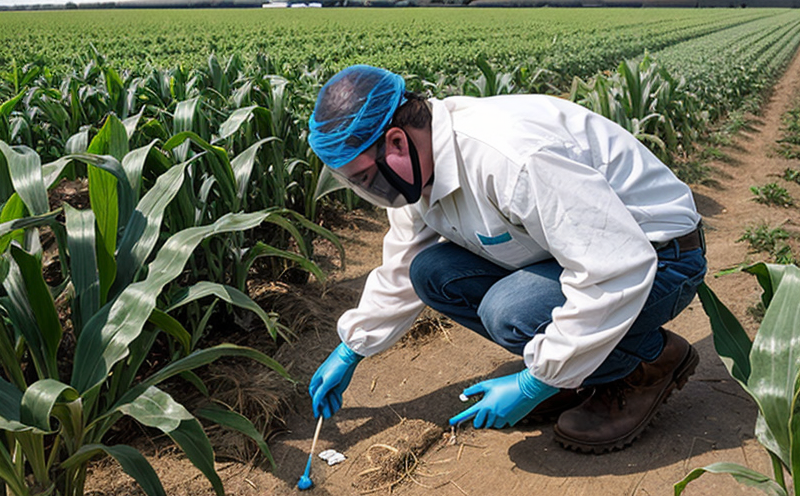Glyphosate Residue Testing in Crops
Glyphosate is one of the most widely used herbicides globally, employed to control broad-spectrum weeds and improve crop yields. However, its presence in food products can pose potential health risks if not managed properly. Hence, testing for glyphosate residue in crops is crucial for ensuring compliance with international standards and safeguarding public health.
The process of detecting glyphosate residues involves several critical steps that are essential to ensure accurate results. Firstly, the specimen must be prepared correctly by collecting representative samples from various parts of a crop field or storage facility. Proper sampling ensures that the analysis reflects the true concentration of glyphosate present in the crop.
After sample collection, it is crucial to transport them under controlled conditions to avoid degradation and contamination. Once back at the laboratory, the samples undergo preliminary processing such as drying, grinding, and extraction using solvents like acetonitrile or methanol. The extracted compounds are then concentrated and purified for further analysis.
The actual detection of glyphosate residues typically employs liquid chromatography-tandem mass spectrometry (LC-MS/MS) techniques which provide high sensitivity and selectivity necessary to identify even trace amounts of the chemical in complex matrices like plant tissue or grain. This method allows laboratories to meet stringent regulatory limits set by organizations such as the World Health Organization (WHO), European Food Safety Authority (EFSA), and United States Environmental Protection Agency (EPA).
It is important to note that different crops have varying tolerances for glyphosate residues due to differences in how they metabolize this compound. Therefore, understanding these variances helps laboratories tailor their testing protocols accordingly. For instance, leafy vegetables may tolerate lower levels compared to cereals because of faster metabolism rates.
The analytical method used should adhere strictly to international standards like ISO 17025 which guarantees the competence and capability of our laboratory. Compliance with such standards ensures that all tests performed are reliable and repeatable, providing confidence in results provided to clients.
Once testing is complete, detailed reports are generated outlining findings including concentrations detected along with comparison against relevant guidelines. These reports serve not only as evidence of compliance but also offer valuable insights into potential issues requiring further investigation or corrective actions within agricultural practices.
In conclusion, glyphosate residue testing plays an integral role in maintaining food safety standards across various sectors including agriculture, healthcare, and consumer goods industries. By adhering to best practices from sample collection through final reporting, laboratories can contribute significantly towards protecting public health while supporting sustainable farming methods.
Why It Matters
The presence of glyphosate residues in crops is a matter of significant concern due to its classification by the International Agency for Research on Cancer (IARC) as "probably carcinogenic to humans." Consequently, stringent regulations have been implemented worldwide to monitor and control these residues. Failure to comply can lead to legal consequences, reputational damage, and loss of market access.
For quality managers responsible for ensuring product safety and integrity, regular testing helps maintain consumer trust and brand reputation. Compliance officers must stay updated on evolving regulatory requirements to avoid non-compliance issues that could disrupt supply chains or lead to costly recalls. R&D engineers benefit from this service by gaining insights into effective pest management strategies without compromising food quality.
From a procurement perspective, sourcing certified glyphosate-free products ensures adherence to company policies and enhances supplier relationships. Additionally, knowing the extent of contamination allows companies to make informed decisions regarding product reformulations or process improvements aimed at reducing environmental impact.
Applied Standards
The testing for glyphosate residues follows internationally recognized standards designed to ensure accuracy, reliability, and consistency across different laboratories. One such standard is ISO 17025 which sets forth the requirements for competence of a particular field or discipline used in the testing laboratory.
For specific analytical methods employed during glyphosate residue detection, EN 16438 provides guidelines on determining residues using LC-MS/MS techniques. This European standard ensures that laboratories adhere to standardized procedures ensuring accurate quantification results. Furthermore, IEC 62705 specifies the measurement of pesticide residues in foodstuffs by gas chromatography with mass spectrometry detection.
The United States Environmental Protection Agency (EPA) also provides its own set of guidelines through Method 1632 which details procedures for determining glyphosate residues using LC-MS/MS. Similarly, the European Food Safety Authority (EFSA) publishes recommendations on appropriate methods and thresholds for pesticide residue testing.
These standards not only guide laboratories in performing accurate analyses but also facilitate comparability of results among different institutions worldwide. By following these guidelines, we ensure that our clients receive consistent, reliable data that meets regulatory expectations both locally and internationally.
Benefits
Regular testing for glyphosate residues offers numerous advantages beyond mere compliance with regulations. It allows farmers to monitor the effectiveness of their pest control measures while minimizing unnecessary applications which can harm beneficial insects and contribute to soil degradation.
Quality managers gain peace of mind knowing that their products meet stringent safety standards, thereby protecting consumers from potential health risks associated with excessive exposure to glyphosate. Compliance officers benefit greatly by avoiding legal disputes or fines resulting from non-compliance incidents.
R&D engineers can utilize this information to develop innovative solutions aimed at reducing reliance on harmful chemicals while enhancing overall crop productivity and sustainability. Procurement teams find value in sourcing certified products that align with corporate social responsibility goals.
Moreover, continuous monitoring supports sustainable agricultural practices by identifying trends over time which inform better decision-making processes regarding pesticide use patterns. Ultimately, these benefits contribute to safer food production processes contributing positively towards global health outcomes.





